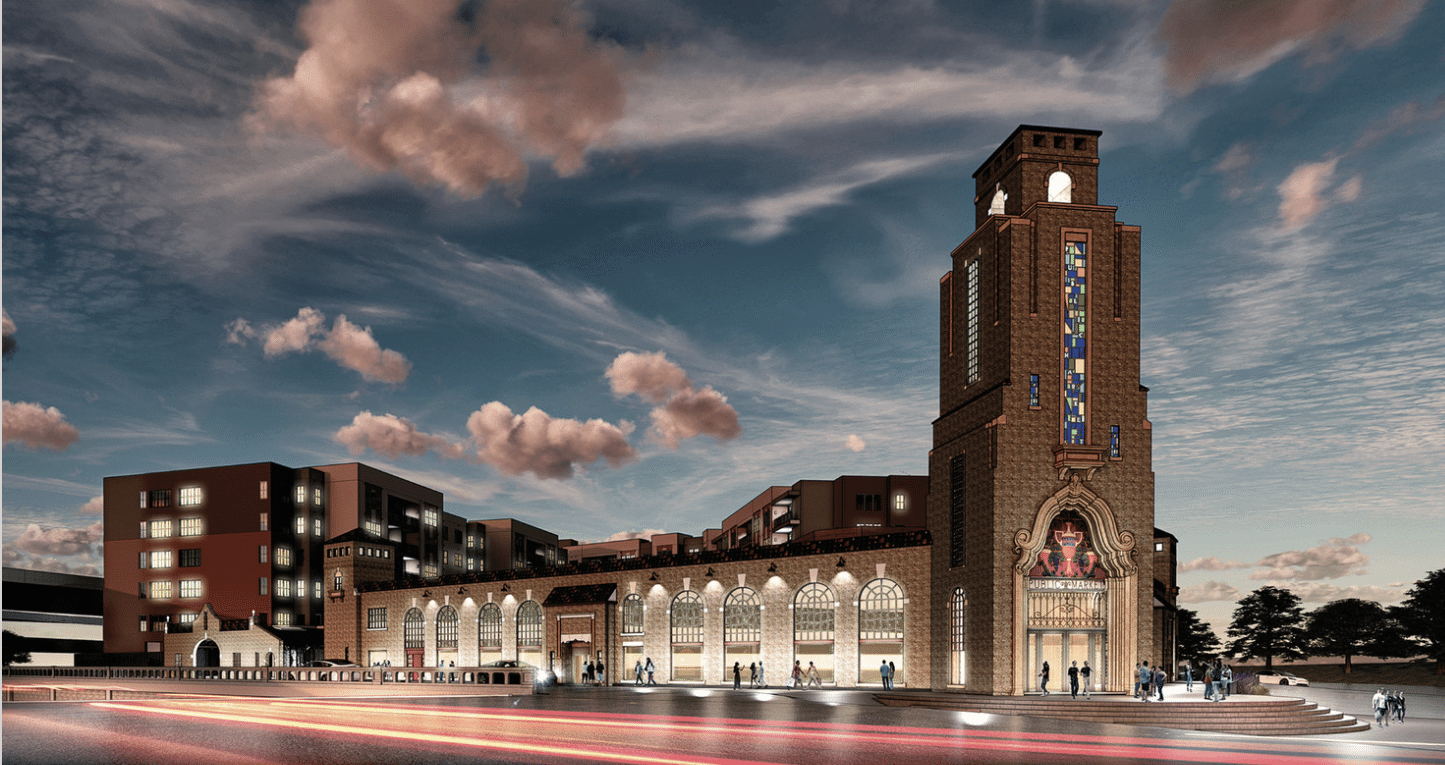
RESTORING A LANDMARK
By Scott Nishimura
Photos by Wilks Development
A FORT WORTH LANDMARK, THE PUBLIC MARKET, FINALLY GETS ITS DAY IN THE SUNSHINE AGAIN
The long-awaited redevelopment of a historic piece of the Fort Worth skyline is finally queued up.
A developer broke ground in June on an estimated $54 million restoration of the historic Fort Worth Public Market and the addition of an adjacent 199-unit luxury senior independent living apartment tower and parking garage.
Wilks Development, of Cisco, expects to complete the project within two years, said Kyle Wilks, president and chief executive. Wilks said The Public Market will include a community space, a restaurant and a cafe open to the public, a fitness center, a coworking center and a leasing office.
“There are a couple of groups we’re talking to that are interested in owning this,” Wilks said of The Public Market space during an interview.
The Fort Worth Public Market, developed in 1930, was a space for farmers, retailers and other sellers to interact with shoppers. In 1930, it had 30 shops and 145 vendor stalls, according to Historic Fort Worth, Inc. The market began declining amid the Depression.
Oilman Bob Simpson, who purchased and restored a number of buildings in Fort Worth, bought The Public Market in 2012 with plans to restore it. He sold the 2.8-acre site to Wilks in 2014.
The property, boarded up and deteriorating, has appeared on Historic Fort Worth’s Most Endangered Places list four times.
“The Public Market is positioned to be the success it should have been,” said Jerre Tracy, executive director of Historic Fort Worth.
The 199 apartments will range in space from 780 square feet to 1,400 square feet and will likely rent for $2.50-$3 per square foot, Wilks said. The property plans to offer concierge service for residents.
“We think what is really going to have its moment of renaissance is service; we lost that during COVID,” Wilks said, likening the feel of the project — called The Harden at The Public Market, after the market’s original developer — to a hospitality experience.
The firm obtained state and federal historic rehabilitation tax credits that will refund “just under 45 percent” of eligible expenses, helping make the project more feasible financially, Wilks said in the interview.
“If you’re trying to do a historic building and not taking advantage of the credits, it is going to be extremely hard,” Wilks said.
Wilks will build about 230 spaces in a parking structure, with a swimming pool
and deck and six stories of residential space above that. Because of historic preservation restrictions, the buildings will be connected only by a covered walkway, Wilks said.
The apartments will range in layout from one to three bedrooms, with open living spaces, Wilks said. The two- and three bedroom apartments will each have two bathrooms. Every apartment will have a balcony, allowing tenants to extend their
living spaces and connect to the outdoors.
“Balconies are critical,” Wilks said.
All of the apartments will have stainless steel appliances. Flooring will be mostly
hardwood and tile, Wilks said.
The concierges will offer a range of basic services, such as dry cleaning dropoff and
pickup and transportation to and from medical appointments, Wilks said. Property management will also schedule outings for residents. The developer has signed Capstone Real Estate Services to manage and lease the property.
“If we create community here and people don’t just go into their apartment home and keep to themselves, they’re going to stay as long as they can,” Wilks said.
Prospective tenants must be at least 62; the property’s target market is 68 and older, he said. “People are living longer,” Wilks said. “Sixty-eight feels a lot like 58. By the time they make decisions, they’re a little more senior.”
After purchasing the property from Simpson, the family firm, based in Cisco in Eastland County, considered several possible uses for the old Public Market, Wilks said.
“We thought about doing hospitality, but we never could get quite comfortable with the walkability (desirable) for hospitality,” Wilks said.
The property, at 1400 Henderson St., is bounded by Interstate 30 to the south, Henderson to the east, and access roads to the north.
“It became apparent that active senior living was the most reasonable” path, Wilks said.
Wilks’ father and uncle started the Wilks Brothers family office in 1995. Kyle’s brother, Josh Wilks, and their cousin Jess Green started Wilks Development in 2011.
The principals have participated in historic projects and senior living developments, but this is the first Wilks Development project in those categories, Kyle Wilks said.
BOKA Powell’s Fort Worth office handled the site plan and architecture; Kimley-Horn, the civil engineering; L2L Development Advisors partners Randy Gideon and Tom Purvis, development consulting; and Mason Joseph Co., financing. NE Construction of Lewisville is the general contractor. Kyle Wilks also credited the federal Department of Housing and Urban Development, city of Fort Worth, Texas Department of Transportation and Historic Fort Worth for their assistance.
“This is a really complicated project,” Mark Dabney, BOKA’s Fort Worth market leader, said. “This is a very significant site to the architectural fabric of Fort Worth.”
The design team was attentive to the historic Public Market building when designing the addition, Dabney said. “The apartments and the pool deck have been designed to complement the existing building.”
“Public Market is not just a building but a symbol of what we can achieve when we work together,” Kyle Wilks said.
